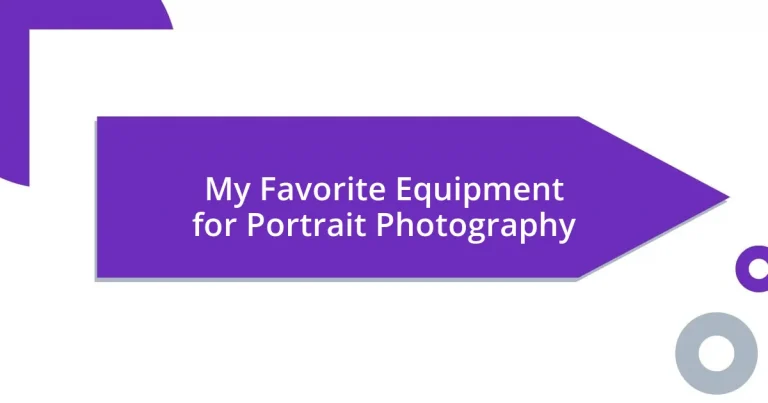Key takeaways:
- Essential gear for portrait photography includes a reliable camera body, appropriate lenses (like 50mm, 85mm, and 135mm), and effective lighting options.
- Lighting can significantly impact the emotional quality of portraits, with natural light offering warmth and softboxes providing controlled illumination.
- Important camera settings for portraits involve using a wide aperture for bokeh, managing ISO for low-light conditions, and maintaining a fast shutter speed to capture sharp images.
- Engaging with your subject and creative composition techniques can enhance the authenticity and storytelling of your portraits.
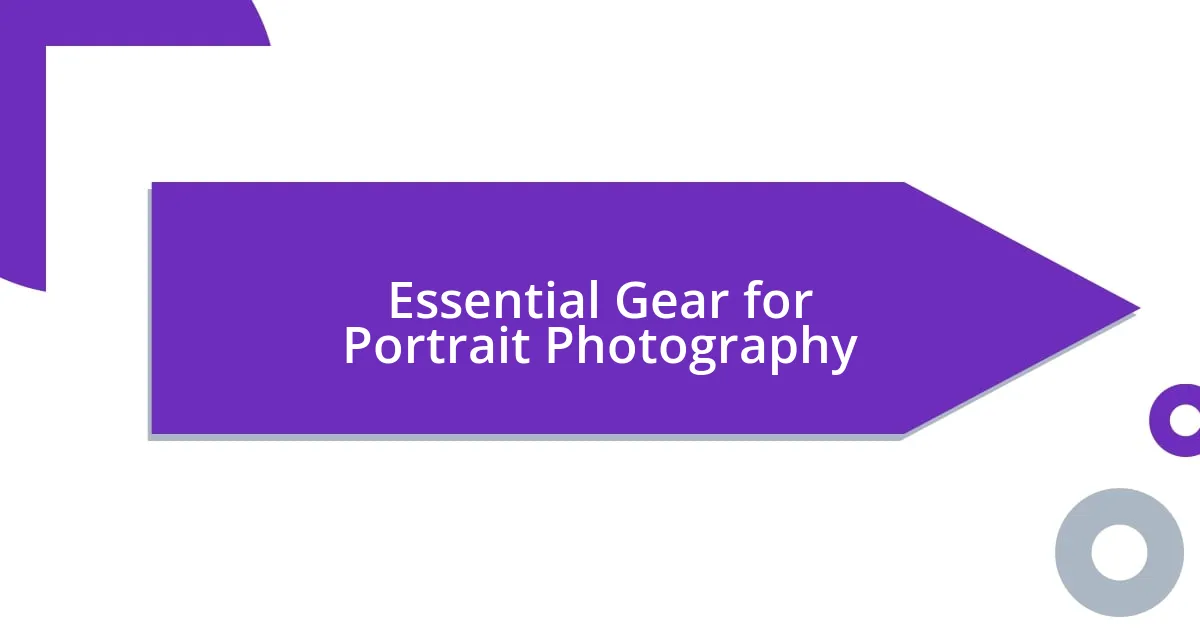
Essential Gear for Portrait Photography
When it comes to essential gear for portrait photography, a reliable camera body is crucial. I remember my first shoot with a DSLR; the moment I realized how much detail I could capture in a subject’s expression was exhilarating. It’s amazing how the right camera can not only elevate the quality of your images but also enhance your confidence as a photographer.
Lens choice is equally important. Personally, I am fond of prime lenses, particularly an 85mm f/1.8, which offers that beautiful bokeh that helps subjects stand out from the background. Have you ever noticed how the right lens can completely transform the mood of a portrait? It’s that magical ability to create intimacy and focus that keeps me coming back for more.
Additionally, lighting gear can make or break your portrait work. I often find myself using a softbox for controlled lighting—it’s like painting with light. Have you tried working with natural light versus artificial setups? The difference can be quite striking, and each has its own emotional resonance, shaping the mood and feel of your portraits in distinct ways.
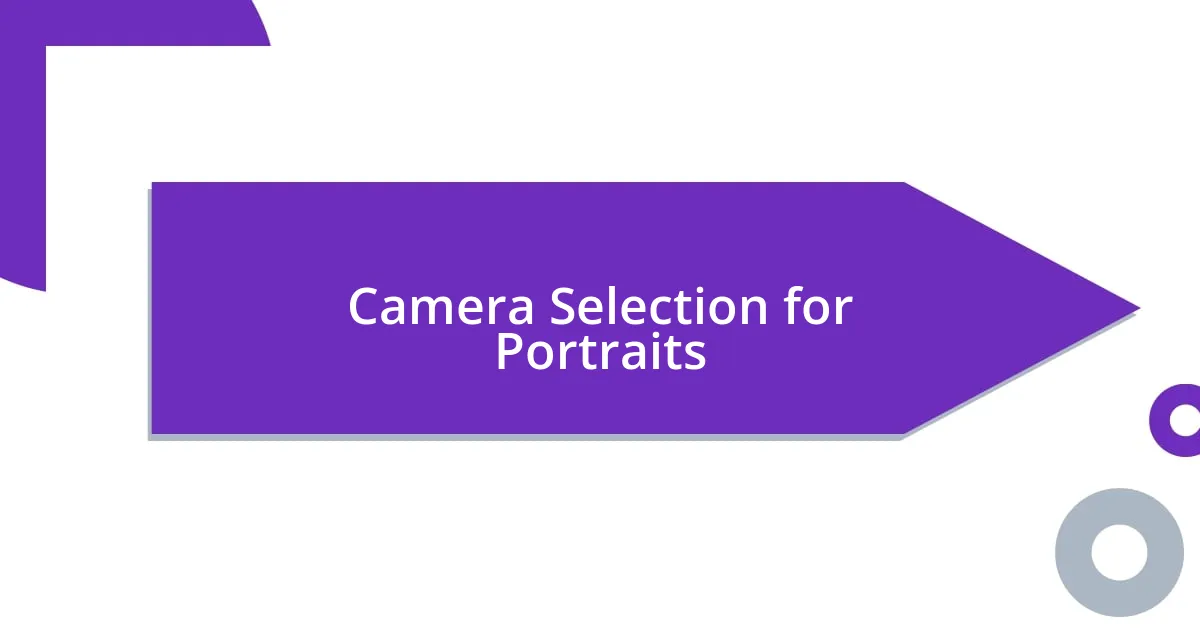
Camera Selection for Portraits
Selecting the right camera for portraits is one of the most impactful decisions any photographer can make. From my experience, I’ve found that full-frame DSLRs or mirrorless cameras tend to excel in capturing the depth and subtlety of human emotion, especially in low-light situations. On one memorable evening, I switched from my usual crop sensor to a full-frame camera, and the difference in image clarity and dynamic range took my breath away.
Here are some key considerations when choosing your camera for portrait photography:
- Sensor Size: Full-frame sensors give better low-light performance and depth of field control.
- Autofocus System: A fast and reliable autofocus system is crucial for capturing sharp images, especially with moving subjects.
- Performance at High ISO: Portraits often occur in varied lighting conditions, so a camera with good high ISO performance helps maintain image quality.
- Shooting Speed: A camera with a rapid burst mode can help catch fleeting expressions that make a portrait unforgettable.
- Lens Compatibility: Consider the variety of lenses available for your camera system; a solid selection of primes can enhance your portrait work significantly.
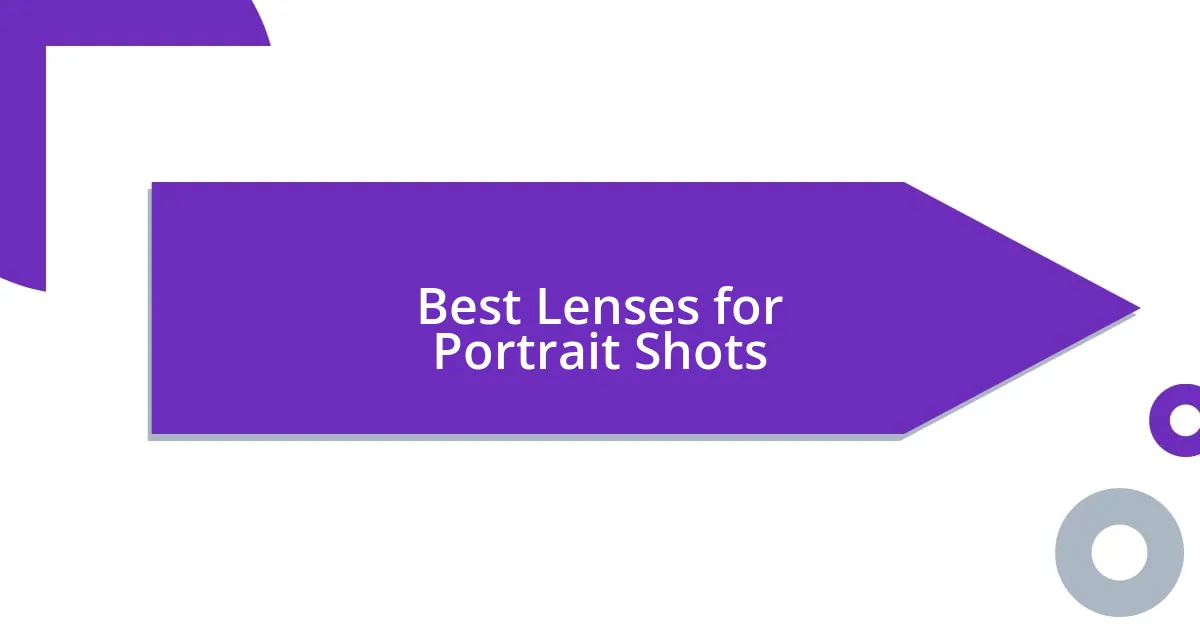
Best Lenses for Portrait Shots
When it comes to selecting the best lenses for portrait shots, the focal length plays a pivotal role. I’ve found that a 50mm lens can be incredibly versatile—it strikes a balance between producing flattering proportions and allowing enough context in the background. A while back, I used a 50mm on a shoot with a talented musician, and it beautifully captured the balance of intimacy and atmosphere that made the portrait memorable.
Moving on, the classic 85mm lens is often lauded as the gold standard for portrait photography. Its ability to provide a pleasing compression of features while creating a creamy bokeh is something I’ve come to love over the years. I remember capturing a close-up portrait during golden hour with my 85mm; the soft, dreamy background made every detail of my model’s expression pop, evoking a sense of vulnerability and depth that I strive for in my work.
Lastly, if you’re stepping into something more specialized, consider a 135mm lens. This lens adds a unique dimension—allowing for greater distance between you and your subject—which can lead to more natural and candid moments. I once used a 135mm at a wedding, and the laughter shared between the couple felt so genuine and unposed, reminding me of the magic that can happen when you create space.
| Lens | Focal Length | Advantages |
|---|---|---|
| 50mm f/1.8 | 50mm | Versatile, allows for contextual shots |
| 85mm f/1.8 | 85mm | Flattering compression, excellent bokeh |
| 135mm f/2 | 135mm | Great for candid shots from a distance |
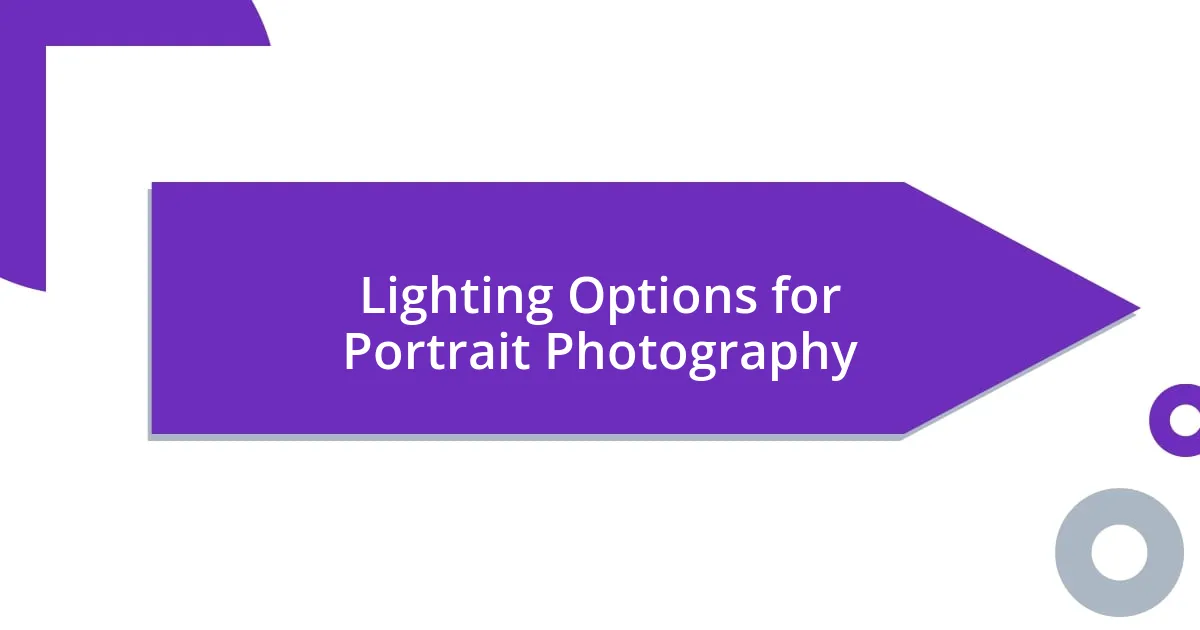
Lighting Options for Portrait Photography
Lighting is one of those foundational aspects of portrait photography that can completely transform an image. I distinctly remember a shoot where I used natural light filtering through a window; the gentle glow highlighted my subject’s features beautifully, evoking a warmth that artificial light struggled to replicate. Have you ever noticed how the soft diffusion of sunlight can wrap around a person and create a serene aura? It’s truly magical.
In contrast, on days when outdoor lighting isn’t cooperating, I’ve turned to softboxes to simulate that dreamy glow. I recall setting up a softbox during an evening shoot, and I was amazed by how it wrapped my subject in a flattering light, reducing harsh shadows and creating a soft, inviting look. It’s fascinating how a little bit of controlled light can exude such a rich emotional quality in portraits.
Then there’s the power of reflectors, which I often consider my secret weapon. I once worked with a model outdoors where the sunlight was harsh, casting unappealing shadows. By simply positioning a reflector to bounce some light back onto her face, I could soften those shadows and add a luminous glow to her eyes. It made such a notable difference! Don’t you think it’s incredible how manipulating light, even in the simplest ways, can elevate a portrait?
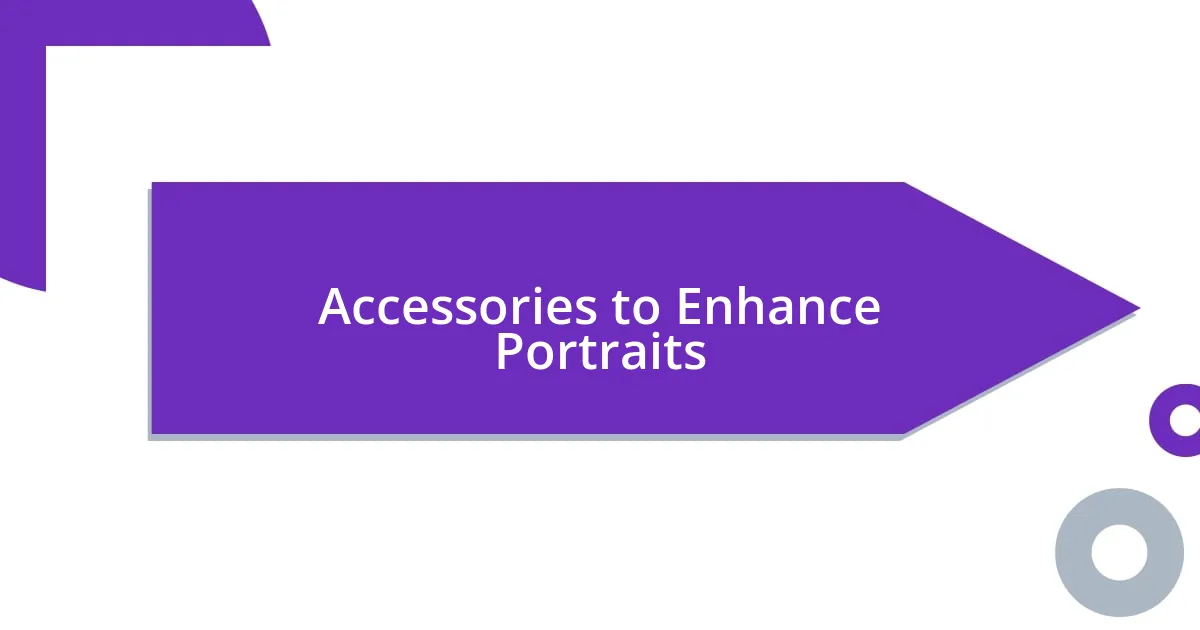
Accessories to Enhance Portraits
When it comes to accessories, a sturdy tripod is often an overlooked but essential tool. I was on a shoot in a beautiful park when I decided to set up my tripod to capture some stationary portraits. The added stability gave me the freedom to experiment with longer exposure times without worrying about camera shake. It was that moment I realized how a simple accessory could take my portraiture to the next level, allowing me to focus more on composition rather than just getting the shot right.
Another accessory that has changed my approach is a remote shutter release. I remember a session with a shy subject who felt more comfortable when I wasn’t hovering over them, camera in hand. Using the remote allowed me to step back and create a space where they could truly express themselves, leading to some authentic and captivating moments. Isn’t it incredible how a little distance and the right accessories can help reveal someone’s true personality in a portrait?
Don’t forget about lens filters, especially polarizers. I once shot a portrait during a golden sunset, where I used a polarizing filter to enhance the colors in the sky and reduce glare off my subject’s skin. The effect was stunning; it offered depth and vibrancy that I hadn’t achieved in previous shoots. Have you ever noticed how something as simple as a filter can change the mood of a photograph entirely? It’s a small accessory that can yield significant results, helping to elevate the overall quality of your portraits.
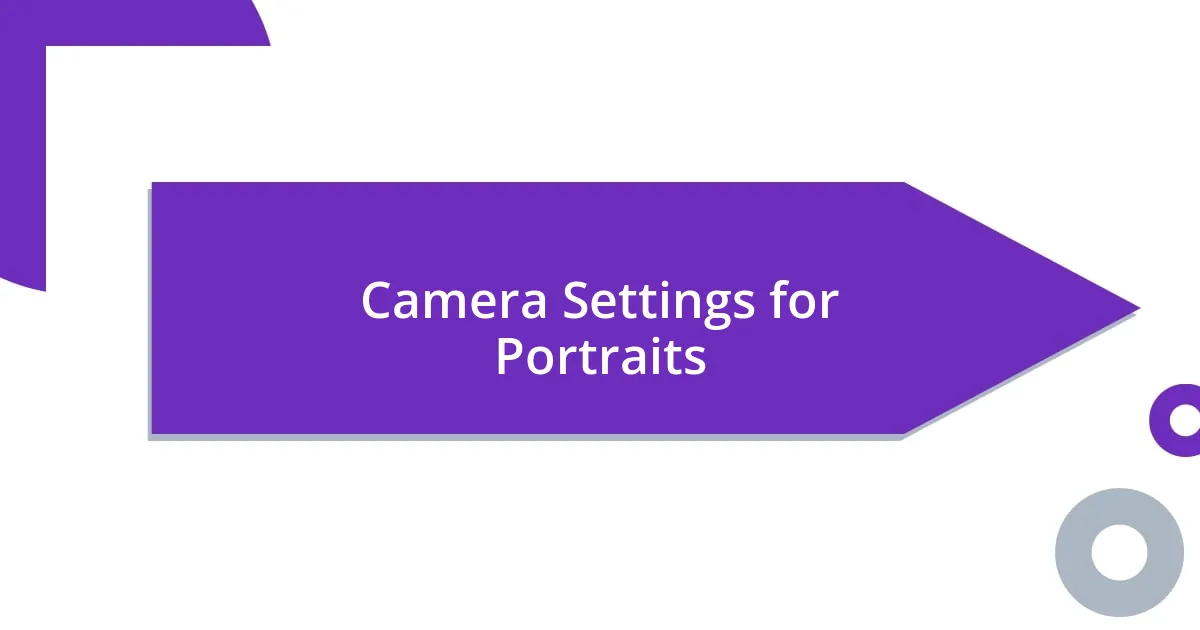
Camera Settings for Portraits
When it comes to camera settings for portraits, I find that a wide aperture is absolutely essential. Personally, I often shoot at f/1.8 or f/2.8 to achieve that lovely background blur, known as bokeh. There’s something so compelling about how it isolates the subject, making them pop against the soft, dreamy backdrop. Have you ever experienced that moment when you capture a portrait where the entire scene seems to fade away, leaving just your subject in focus? It’s truly a rewarding experience.
Another key setting I prioritize is the ISO. In low-light situations, I’ve bumped the ISO up to 400 or even 800, while being mindful of noise levels. I still remember a shoot in a cozy café where the ambient light was low, but cranking up the ISO allowed me to capture those candid moments without introducing too much grain. Do you feel anxious about noise in your images? I used to, but I’ve learned that it’s all about finding the right balance; sometimes a little noise adds character!
Shutter speed also plays a crucial role in my portraits. Typically, I won’t go below 1/125s to keep things sharp, especially if your subject is moving even slightly. During one particular shoot, I was photographing a dancer, and I was so grateful for that fast shutter speed. Capturing their grace in motion made all the difference! Doesn’t it feel amazing to freeze a moment in time and see the energy in a photo? It’s those tiny adjustments that can elevate your work from simply good to truly unforgettable.
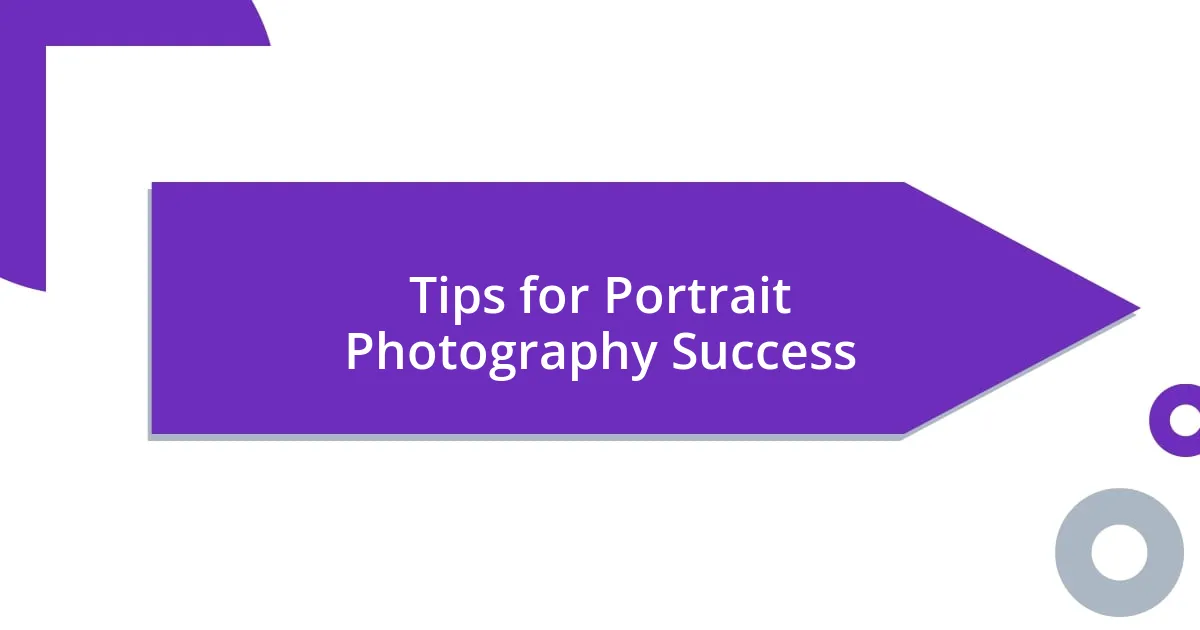
Tips for Portrait Photography Success
One crucial tip I’ve learned for successful portrait photography is to pay close attention to lighting. I remember shooting a portrait session outdoors during the golden hour right before sunset, and the natural light was just magical. It created a soft, warm glow that brought my subject’s features to life. Have you ever experienced that enchanting moment when the light wraps around your subject, highlighting their best attributes? It’s one of the simplest yet most powerful tricks to create stunning portraits.
Engaging your subject is also pivotal. I tend to start with light conversation to ease any nerves. On one occasion, I worked with a nervous teen who was unsure about being photographed. After sharing some laughs and asking about their favorite hobbies, I noticed a transformation; they began to relax, and their genuine smile emerged naturally. Isn’t it fascinating how connection can unveil an individual’s true spirit? When you build a rapport, you’re not just taking a photo; you’re capturing a moment of authenticity.
Lastly, composition can’t be overlooked. I often challenge myself to think outside the traditional framing by using negative space creatively. I once took a portrait of a woman surrounded by tall grass, leaving ample empty space on one side. The result was a striking contrast that drew attention to her and conveyed a feeling of calm solitude. Have you considered how the arrangement of elements can evoke different emotions in your portrait? It’s amazing how small shifts in composition can lead to dramatic improvements in storytelling within each image.












